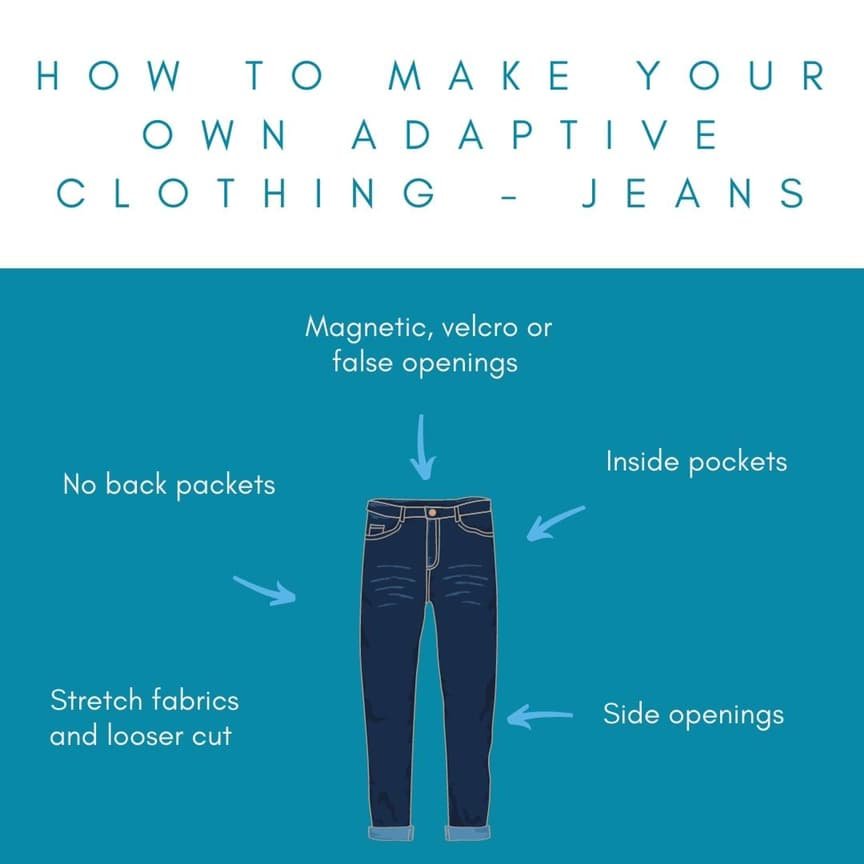How to make your own adaptive clothing: Jeans
Do you find it hard to find jeans that fit and that are easy to get on and off? I know that some of my clients do.
Jeans should fit at the waist and the hips, without being to saggy and baggy. These are hard for anyone to find, let alone finding ones that are still easy to get on and off when you have a disability.
Let’s have a look at how to tailor your jeans to make them more accessible and stylish.
Good Fitting Jeans
There is no point adding adaptive features to jeans if they don’t fit well to start with.
There are 3 key features that determine the fit of jeans:
Waist to Hip ratio
Rise Height - the length between where you legs bend at your hip to where your waist is narrowest
Leg Length
You will get a better and more comfortable fit if you match the your jeans to your rise. For example, I have a long rise, so I find high rise jeans more comfortable and hipsters either don’t fit or fall of. If you have a low rise, the low rise jeans and hipsters will be more comfortable.
You will find the the rise at the front and back of jeans is different. This is because people have different sized bottoms. You may also need to accommodate a tummy at the front. Rise is normally determined when standing, but when we sit our effective rise changes, becoming shorter at the front and longer at the back. If you spend most of your time seated, you may want to look at your seated rise. This means that your jeans will be slightly baggy at the back when standing, but will be much more comfortable when seated.
Leg length is often given, or you can ask the supplier for the leg length. If in doubt chose a longer length jean and get them shortened. Just be aware that you may lose any detailing on the hemline. If you can’t find jeans that are long enough, think about adding some extra fabric or lace at the bottom. You may be able to combine two pairs of jeans to get the fit that you want.
Waist to hip ratio is more difficult to assess and there is no consistent standard. Choose jeans to fit your widest point and tailor them to fit your smallest point. However, look at the adaptive guidelines first. If you struggle in this regard, look for jeans with a high percentage of elastane. These will have more stretch and be more forgiving.
If we look at the popular brand Levi’s, their 501s Original Straight Leg jeans are 100% cotton with no elastane while their 514 Shaping Straight Leg jeans have 2% elastane. The 514 will fit more people than the 501s.
If you have difficulty finding jeans with a good fit it is worth shopping around and checking the label for at least 2% elastane before trying any on.
Adaptive Jeans
Having a health issue or disability is no reason to give up jeans.
There are regular jeans on the market with elasticised waists, but there are also adaptive jeans on the market that have a more traditional look.
Some of these adaptations can be incorporated into your existing clothes if you sew or have a good tailor.
1) A magnetic, velcro or false opening creates the traditional jeans look without the need to do up zips or buttons.
2) Side openings make adaptive jeans easier to put on - and to wear with prosthetics. You can make side openings as long as is comfortable.
3) Remove back pockets to reduce the occurrence of pressure sores.
4) Stretch fabrics and a slightly looser cut enable easier access, but also allow for extra fabric to make tailoring them easier.
5) Inside pockets on the legs give somewhere for pumps and bags to be stored without needing to strap them to the body.
6) Add thigh pockets for easy access while seated.
7) Add pull tabs to make them easier to pull on.
While adapting your existing clothes can reduce the waste going into landfill and expand the range of options available, it is sometimes better to purchase adaptive clothing instead.
Adaptive clothing measures like seated pants and longer legs need to be built in from the start.
Adaptive Jeans Suppliers
While there are lots of suppliers of adaptive pants (trousers and casual pants) in Australia, there are less that supply jeans.
EveryHuman stock a range of adaptive jeans
Christina Stephens have some jeans-style pants
Able Clothing have seated denim pants
Outside of Australia the following suppliers stock adaptive jeans.

